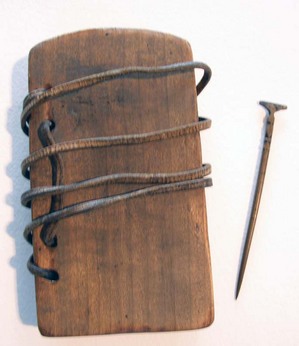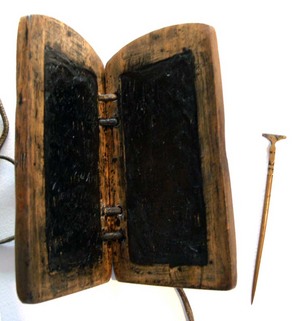“A diptych is a sort of notebook, formed by the union of two tablets, placed one upon the other and united by rings or by a hinge. These tablets were made of wood, ivory, bone, or metal. Their inner surfaces had ordinarily a raised frame and were covered with wax, upon which characters were scratched by means of a stylus. Diptychs were known among the Greeks from the sixth century before Christ. They served as copy-books for the exercise of penmanship, for correspondence, and various other uses”. (See the Catholic Encyclopedia entry: [http://www.newadvent.org/cathen/05022a.htm])
Wax coated tablets (either singularly or in bound diptyches) provided an inexpensive, portable, and reusable writing surface. Today, we say “start with a clean slate,” after the clerics who would clear the wax surface of their tablets using the flat top of the writing stylus.
The wood diptych and bronze stylus in graphic arts measures 9.5 x 17 x 9.5 x 2 cm with four holes in each tablet bound together with a leather strap. It is assumed that our first curator, Elmer Adler, had this made for teaching.
For more on the history of writing, see Bernhard Bischoff (died 1991), Latin Palaeography: Antiquity and the Middle Ages (Cambridge; New York: Cambridge University Press, 1990). Firestone Z114 .B5713 1990


I tried all day to think of some witty comment to write on your blog but all I got is "Of course, it’s very easy to be witty tomorrow, after you get a chance to do some research and rehearse your ad libs."
Do you know about using one?